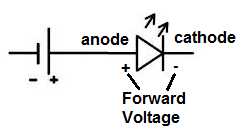What is the Forward Voltage, VF , of an LED?

The forward voltage of an LED, VF, is the voltage that must be applied across the leads of the
LED, from anode to cathode, in order
for the LED to turn on.

As you can see above, positive voltage must be applied across the LED from its anode to its cathode. If reversed, this is no longer
forward voltage but reverse voltage, and the LED will not light up. Forward Voltage is positive voltage applied across the LED's anode to its cathode.
Different kinds of LEDs have different forward voltage requirements. Non-bright LEDs tend to require less voltage than bright LEDs, since bright LEDs need more power to work. Typical VLED values are 1.7V for non-high-brightness red, 1.9V for high-brightness high-efficiency low-current red, 2V for orange and yellow, 2.1V for green, and 3.4 to 3.6V for bright white and most blue types.
In order to make sure that this voltage gets dropped across the LED, you should use a voltage greater than the LED's
forward voltage. Use at least 3V supply voltage for lower-voltage LEDs and 4.5V for 3.4V types. Also add a resistor in series with the LED
to limit excess current from burning out the LED, usually so that the current flowing through the LED is about 20mA. Make sure that the current
doesn't exceed the maximum current specified on the LED's datasheet.